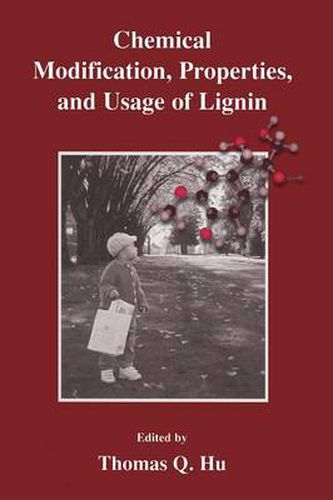Readings Newsletter
Become a Readings Member to make your shopping experience even easier.
Sign in or sign up for free!
You’re not far away from qualifying for FREE standard shipping within Australia
You’ve qualified for FREE standard shipping within Australia
The cart is loading…






This title is printed to order. This book may have been self-published. If so, we cannot guarantee the quality of the content. In the main most books will have gone through the editing process however some may not. We therefore suggest that you be aware of this before ordering this book. If in doubt check either the author or publisher’s details as we are unable to accept any returns unless they are faulty. Please contact us if you have any questions.
Lignin, a plant constituent, is the second most abundant biopolymer on earth. The biosphere is estimated to contain 3 x 1011 tonnes of lignin with an annual biosynthesis rate of approximately 2 x 1010 tonnes. In order to make paper products, wood in the form of whole logs, chips or sawmill residues first need to be reduced to discrete fibres/pulps by a chemical or mechanical pulping method. In chemical pulping of wood, fibres are produced in a yield of 45-55% through the dissolution of lignin by the pulping chemicals. The dissolved lignin, about 50 million tonnes per year, is used as a low-grade fuel for the chemical pulping process. There is a tremendous economics incentive to find better uses of such enormous amount of lignin. In mechanical pulping of wood, fibres are produced in a yield of 90-98% through the action of mechanical forces that separate the fibres but retain the lignin. The main use of high-yield, lignin-rich mechanical wood fibres has been confined to low-quality, non-permanent papers such as newsprint and telephone directories due to the light-induced photooxidation of lignin. Effective photostabilisation of lignin in mechanical wood fibres/pulps will enable their wider use in high-quality paper products. In Asia and other areas of the world where forest resources are less abundant, non-wood plant materials such as straw, bagasse and bamboo have been used to make paper products for many centuries. The effective isolation and the product development of lignin from chemical pulping of non-wood plant materials have become increasingly more important because the internal use of the lignin is technically complex and the traditional way of discharging the lignin-containing, pulping spent liquors to the environment is no longer acceptable. This volume covers the areas of chemical modification of lignin, from chemical pulping of wood and non-wood materials, the properties and usage of the modified lignin as components of polymer composites, and as fine chemicals, fertilizers, pulping catalysts, and so forth. It also describes the recent advances in chemical modification lignin aimed at photostabilization and upgrading of high-yield, lignin-rich mechanical wood pulps/papers.
$9.00 standard shipping within Australia
FREE standard shipping within Australia for orders over $100.00
Express & International shipping calculated at checkout
This title is printed to order. This book may have been self-published. If so, we cannot guarantee the quality of the content. In the main most books will have gone through the editing process however some may not. We therefore suggest that you be aware of this before ordering this book. If in doubt check either the author or publisher’s details as we are unable to accept any returns unless they are faulty. Please contact us if you have any questions.
Lignin, a plant constituent, is the second most abundant biopolymer on earth. The biosphere is estimated to contain 3 x 1011 tonnes of lignin with an annual biosynthesis rate of approximately 2 x 1010 tonnes. In order to make paper products, wood in the form of whole logs, chips or sawmill residues first need to be reduced to discrete fibres/pulps by a chemical or mechanical pulping method. In chemical pulping of wood, fibres are produced in a yield of 45-55% through the dissolution of lignin by the pulping chemicals. The dissolved lignin, about 50 million tonnes per year, is used as a low-grade fuel for the chemical pulping process. There is a tremendous economics incentive to find better uses of such enormous amount of lignin. In mechanical pulping of wood, fibres are produced in a yield of 90-98% through the action of mechanical forces that separate the fibres but retain the lignin. The main use of high-yield, lignin-rich mechanical wood fibres has been confined to low-quality, non-permanent papers such as newsprint and telephone directories due to the light-induced photooxidation of lignin. Effective photostabilisation of lignin in mechanical wood fibres/pulps will enable their wider use in high-quality paper products. In Asia and other areas of the world where forest resources are less abundant, non-wood plant materials such as straw, bagasse and bamboo have been used to make paper products for many centuries. The effective isolation and the product development of lignin from chemical pulping of non-wood plant materials have become increasingly more important because the internal use of the lignin is technically complex and the traditional way of discharging the lignin-containing, pulping spent liquors to the environment is no longer acceptable. This volume covers the areas of chemical modification of lignin, from chemical pulping of wood and non-wood materials, the properties and usage of the modified lignin as components of polymer composites, and as fine chemicals, fertilizers, pulping catalysts, and so forth. It also describes the recent advances in chemical modification lignin aimed at photostabilization and upgrading of high-yield, lignin-rich mechanical wood pulps/papers.